Francisco de Goya's work is universally famous for its spectacular quality, its modernity and its commitment. The Fuendetodos teacher was a pioneer in technique and subject matter; a nonconformist in a society where he never quite fit in, but who surrendered to his dazzling artistry.
"Time also paints"
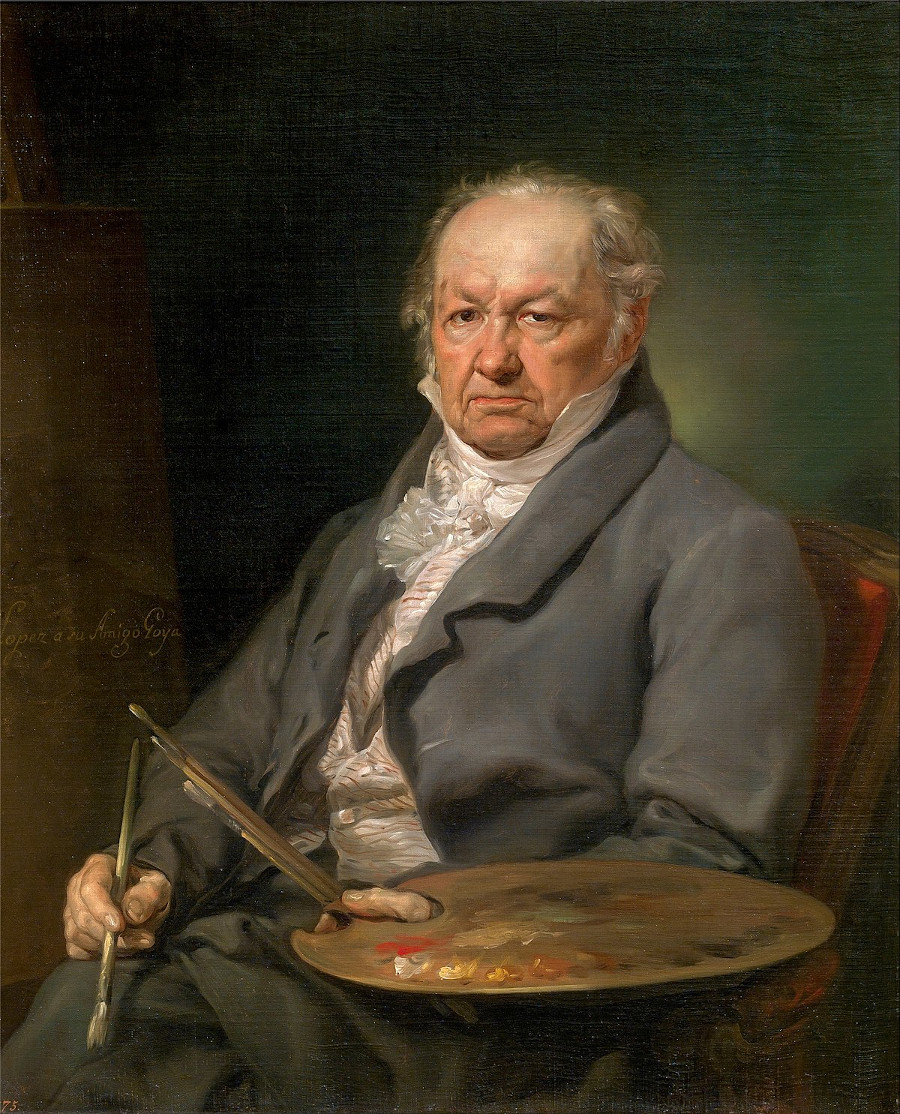
“The painter Francisco de Goya” (1826). Oil on canvas. Vicente López Portaña. Prado Museum
The Prado Museum is among the world's greatest art galleries and of all its rooms, the ones that draw visitors like a magnet are those showcasing the works of Francisco de Goya ~ one of the most important, charismatic and iconoclastic painters ever in the history of painting. His "Black Paintings" and engravings suite are much admired for their astonishing modernity and break from the norms of their time; his Costumbrista, portrait and religious paintings dazzle with the light they emit and the contemporaneity of their brushstroke which transforms them into works that are almost pre-Impressionist. His concept of art transcended that of the mere reflection of what surrounded him, instead interpreting his work as something in constant evolution: "Time also paints," he said on more than one occasion.
Goya's case is almost unique in the history of art, comparable only to that of masters such as El Greco or Turner. It is the story of those artists who shunned the schools of their time to pursue an art that would not be understood until many decades later, the intentions of their art being different, very different from those of their contemporaries. In Goya's own words: "The exceptional qualities of their work are ruined by these mannered masters, who always see lines and never bodies. But where do they find lines in nature? All I can see are light bodies and dark bodies, planes that move backwards or forwards, reliefs and concaves." - words that many avant-garde artists of the 20th century could subscribe to, written more than 150 years earlier.
Early learning and a trip to Italy
Francisco de Goya was born in Zaragoza on 10 March 1746 with art running through his veins, the son of a master gilder and a mother from the lower rungs of the aristocracy. In the mid-18th century, Zaragoza was a rich and powerful city with a flourishing business in the construction of churches and convents which then needed craftsmen to decorate them with altarpieces, paintings and panels. Goya's father's skills were much sought-after and he decided to push his children's aspirations along the same path. The future Court painter took his first steps towards paper and canvas aged 13 under the tutelage of José Luzán Martínez, who had been schooled by Neapolitan painters and whose influence would prove decisive in Goya's attraction to Italian painting. After Luzán Martínez, Goya continued his apprenticeship with Francisco Bayeu and, at the age of 17, applied for a grant and tenure from the Royal Academy of Fine Arts of San Fernando but was turned down. A further application in 1766 was again unsuccessful.
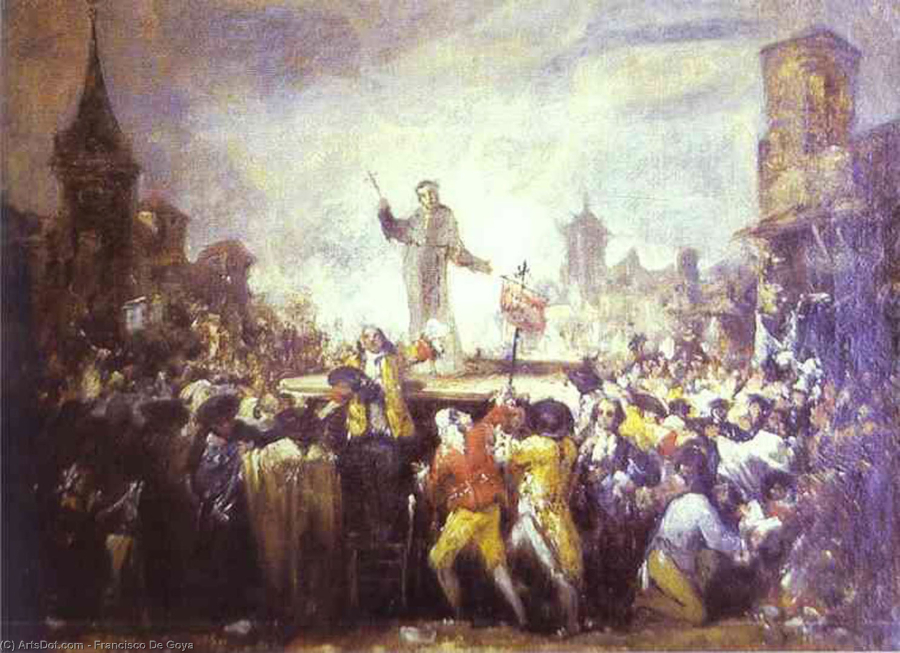
"The Esquilache Riots" (circa 1766)
Works attributed to Goya at this time are scarce, with some religious-themed paintings remaining but the one that stands out most is "The Esquilache Riots" (c. 1766). It is an ensemble painting that depicts an actual incident of great intensity and social relevance and displays some of what will become future constants in his work: the theatrical use of light and shadows, loose brushstrokes, vibrant colours, movement and a marked interest in balance and composition. In 1770, the young artist travelled to Italy, where his passion for masks, popular customs and street theatre was born - a passion that tallies with his fascination with people's faces and grotesque figures. During the trip, Goya decided to submit his entry in a competition held by the Academy of Fine Arts of Parma: "Hannibal the Conqueror views Italy for the first time from the Alps". While Goya's eponymously-titled painting garnered good reviews, the potency and "lack of realism" of the colours did not convince the jury to award him first prize. Goya's risky, personal and vibrant artistic style was already standing out for its modernity against the obvious academicism of his colleagues.
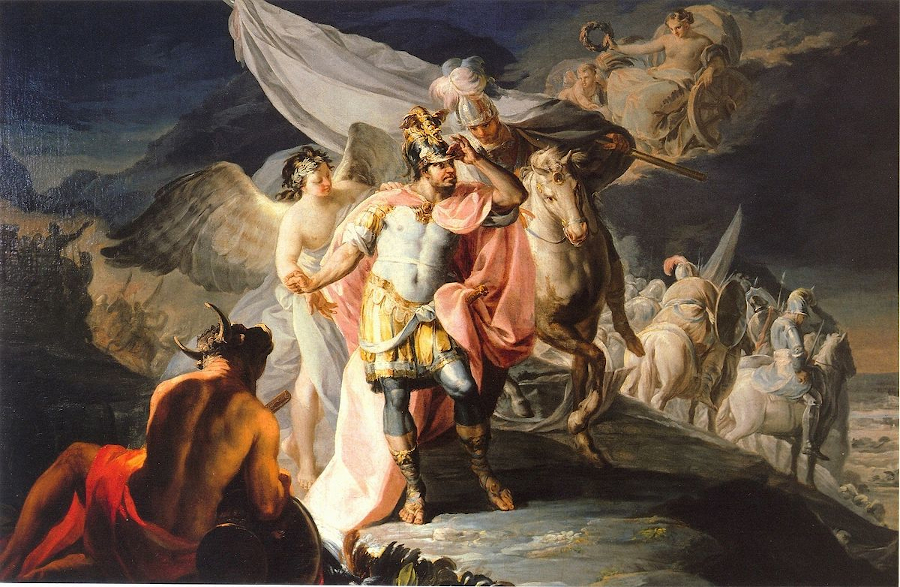
"Hannibal the Conqueror views Italy for the first time from the Alps" (1770). Selgas-Fagalde Foundation
First steps to success. Frescoes and Tapestry Cartoons
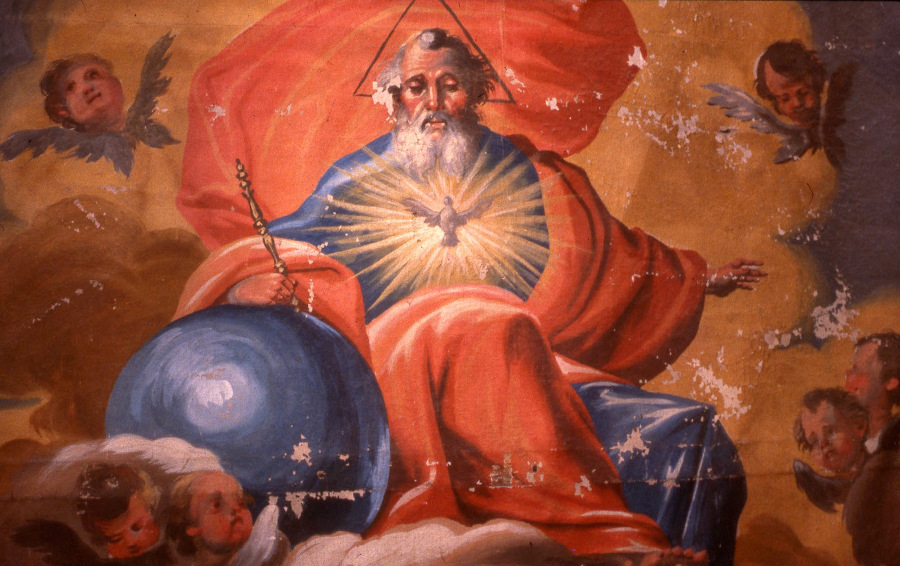
Detail from the Chapel of the Conde de Sobradiel, Zaragoza (1770). Barboza Grasa Archive
On his return, a now 25 year-old Goya takes on his first important commission: to paint a fresco in one of the vaults of Zaragoza's Basilica of the Pillar, applying the techniques learnt during his stay in Italy. This work wins him more contracts: frescoes for churches and palaces and, primarily, portraits of the Aragonese aristocracy. It was during this time that he completed paintings to decorate the chapel of the Palace of the Count of Sobradiel. His work earns him a certain fame and a stable position, factors that convince his former teacher, Francisco Bayeu, to allow Goya to marry his sister Josefa. Of all the seven children from their marriage, only the youngest, Francisco Javier Pedro, will survive to adulthood. How deeply the deaths of his children tormented the artist's soul will emerge later in his "Black Paintings", "Caprichos" and "Disparates" print series.
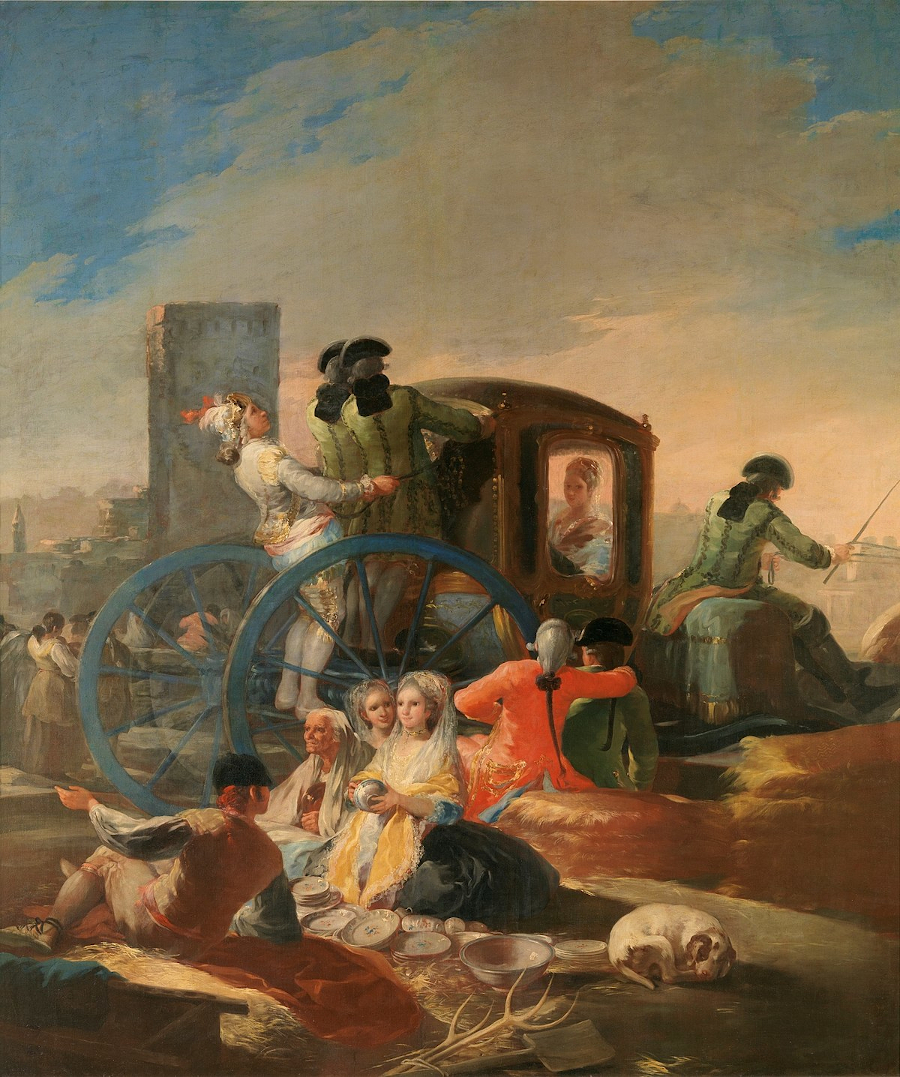
"The Pottery Vendor” (1779). Tapestry cartoon for The Royal Factory of Santa Barbara
1775 was to be a crucial and life-changing turning point for Goya. Anton Raphael Mengs, first painter to King Charles III and also commissioned as master painter by other European courts, calls on him to design and paint tapestry cartoons for the Royal Factory of Santa Barbara. The first ones were painted that same year: a total of nine works, each serving as a pattern guide for tapestries destined for The Royal Seat of San Lorenzo of El Escorial. Goya continues his production and the following year begins another series of cartoons, this time destined for the collection of the Palace del Pardo. Between 1778 and 1780, he both worked and lived at court which afforded him the opportunity to befriend the then Secretary of State, the Count of Floridablanca. This and other relationships, together with his undeniable talent and the originality of his work, guarantee him stability and Goya will then take his first steps towards becoming the future Court Painter. In 1780, he presents "Christ on the Cross" in support of his application to enter the Royal Academy of San Fernando and is admitted unanimously
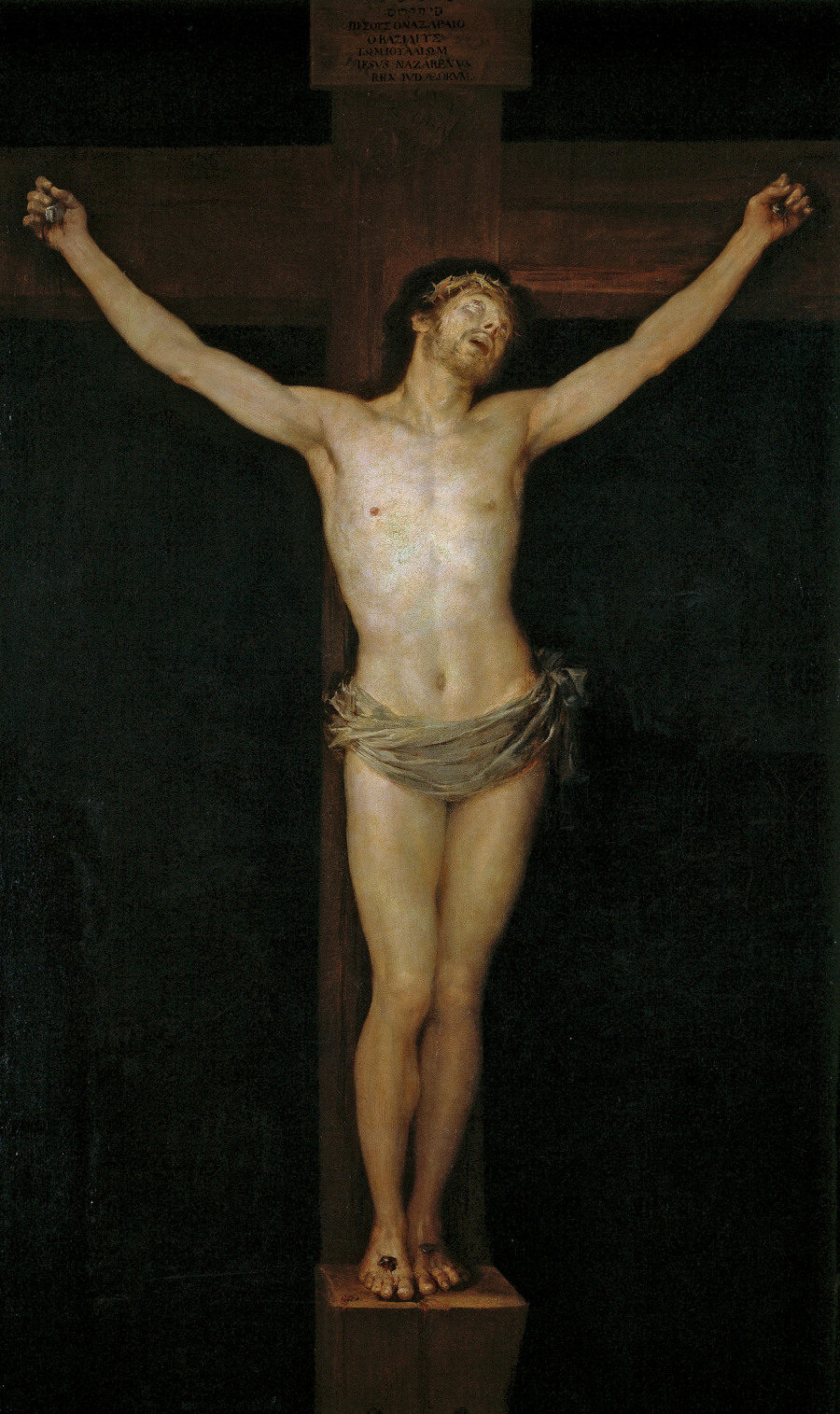
"Christ on the Cross” (1780). Prado Museum
A career on the rise: Jovellanos, Ceán Bermúdez and the Enlightenment
In that era, art and painting were characterized by their ironfisted academicism. Neoclassicism cast a long shadow over artists forced into ironclad and stereotypical constraints based on centuries-old rules. Goya rebels against these impositions and chooses his own path, something that will characterize his work and attitude for most of his life. The 1780s bring him both successes and failures; from the rejection of audiences and academics alike to his Virgin Mary frescoes for the Basilica of the Pillar, to the unreserved acclaim for his "Saint Bernardine of Siena preaching to Alfonso V of Aragón" (1873), created for an altar of the Basilica of Saint Francis the Great. With his fame now well-established, Goya devotes time to painting the portraits of important families and members of the upper classes such as the Duke of Osuna and the Earl of Floridablanca. In fact, the patronage of the Dukes of Osuna was to win him numerous commissions.
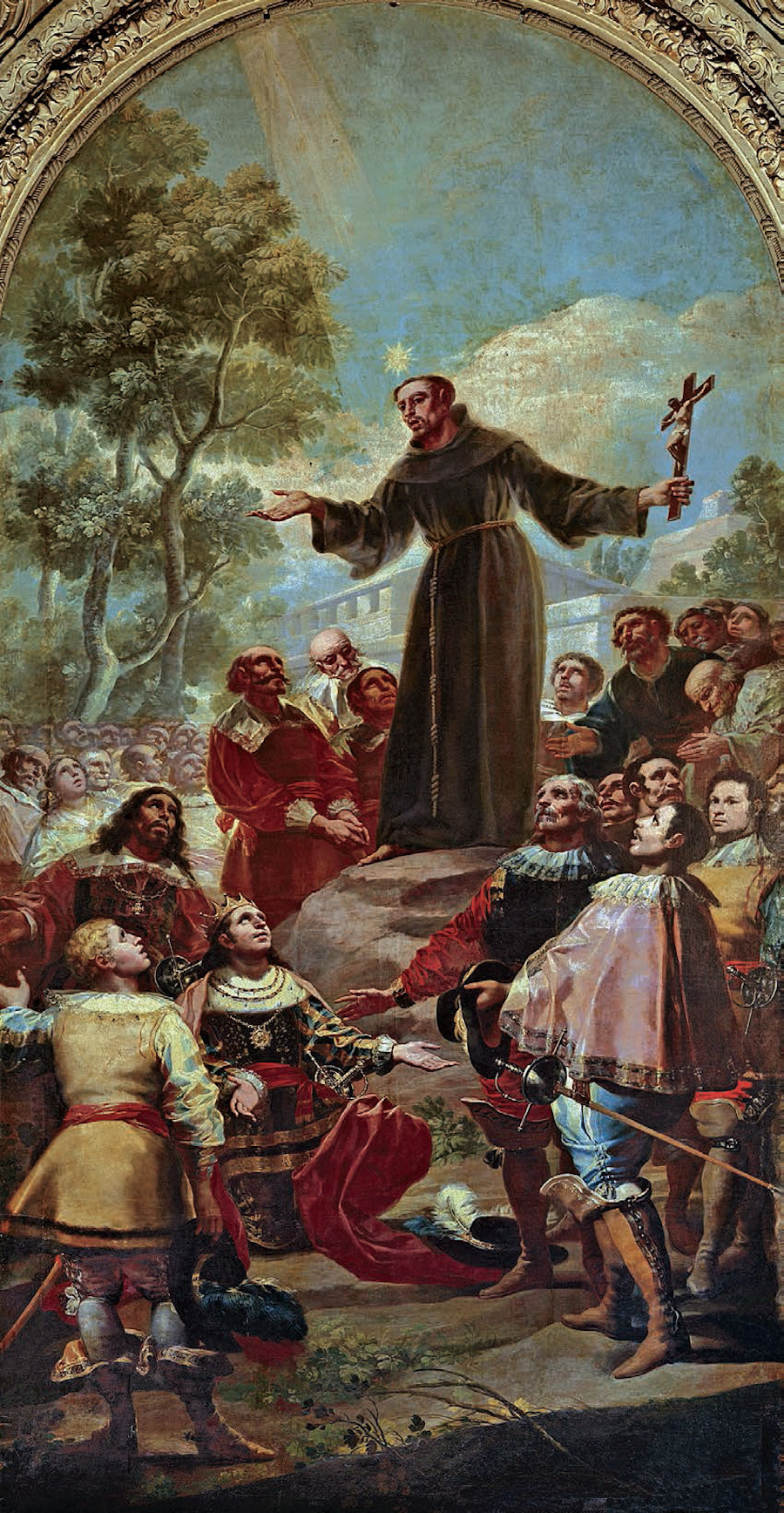
"Saint Bernardine of Siena preaching to Alfonso V of Aragón” (1781-83). Basilica of Saint Francisco el Grande
Goya's anxious soul propels him towards certain environments, individuals and ideas that would become fundamental throughout his life. At this time, he makes the acquaintance of Gaspar Melchor de Jovellanos and the art collector Juan Agustín Ceán Bermúdez. Through these friendships, his career as a painter continues to rise, thanks to the numerous commissions they secured for him. However, these commissions were by no means the most important benefit he receives from his friends: they open the doors to intellectual and reformist circles advocating for the Enlightenment to come to Spain. It is a discovery that impacts the artist, who immediately identifies with these new views on education and politics. These are critical and revealing moments which also affect his painting; his canvasses begin to abandon idealist and perfectionist concepts in pursuit of expressionism, as represented by the exaggerated and the grotesque. Unknowingly, Goya becomes one of the forerunners of a movement that would soon spring up throughout Europe: Romanticism.
Ill health, nudes and war. The time of realism.
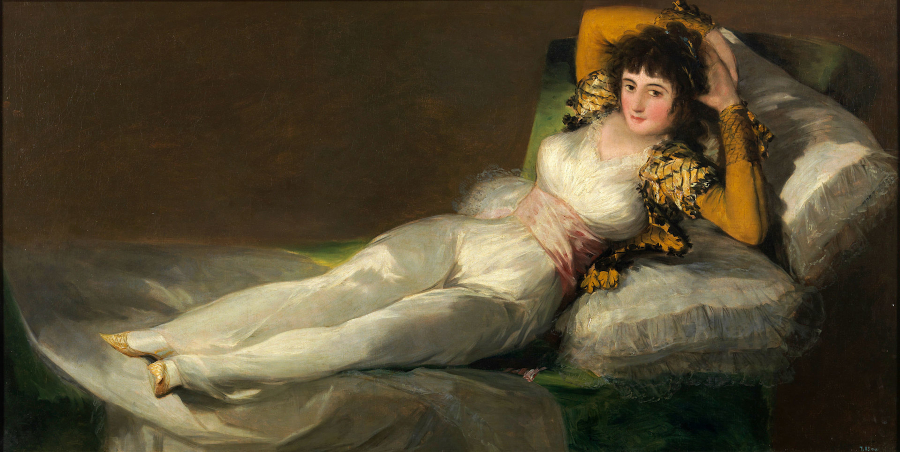
"The Clothed Maja" (1800-1807). Prado Museum
1792 is a dark year in the life of Francisco de Goya. While travelling around Andalusia, he suffers a terrible illness that leaves him profoundly deaf at the age of 46, a deafness that will accompany him until his death and infuse many of his thoughts and paintings with blackness. The painter finds refuge in his art and creates a series of small paintings where the presence of tragedy and crime is strong. However, Goya rises phoenix-like from the ashes and in 1795 becomes Director of Painting at the Academy of Fine Arts of San Fernando. He continues as a portraitist to the nobility, even securing the patronage of the recently-widowed Duchess of Alba. The artist continues to develop his interest in the grotesque, popular folk traditions and social criticism through his engravings, as evidenced in the "Caprichos" (1799). At this time, he also paints his famous works "The Clothed Maja" and "The Naked Maja", which would later bring him the wrath of the Inquisition.
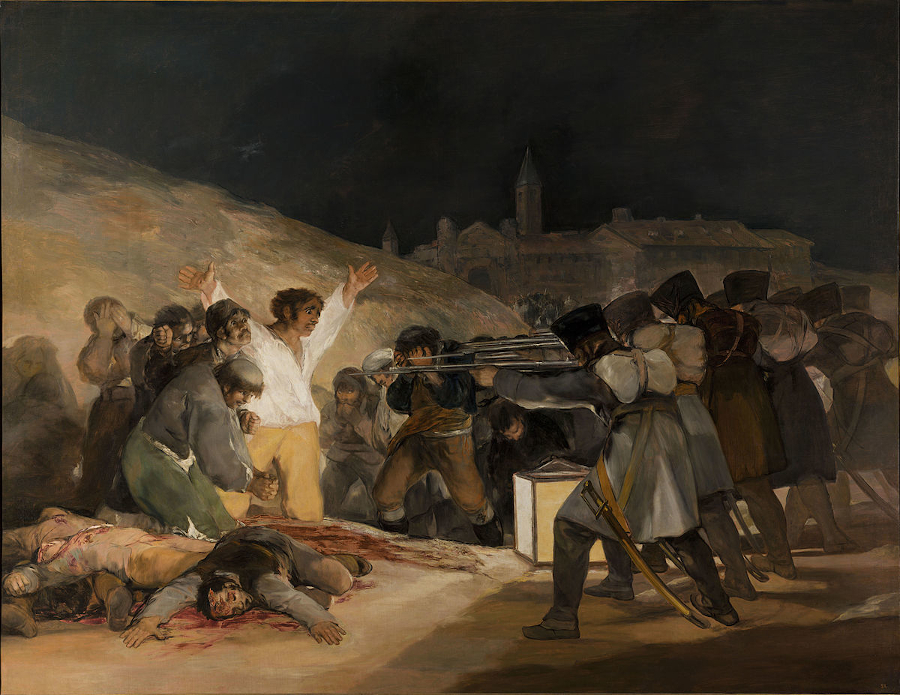
“The 3rd of May 1808 in Madrid" (1813-14). Prado Museum
On the outbreak of the War of Independence (1808-1814), Goya is obliged to be seen to take the government's side, although his output does remain critical in series such as "Disasters of War". His wife, Josefa, dies in 1812 which is when it is believed he begins a relationship with Leocadia Zorrilla. After the war, he continues to work as Court Painter to the king and nobility, even going so far as to paint the portrait of Ferdinand VII, the "Felon King" and self-declared absolute monarch he neither liked, respected nor accepted. However, despite only showing the regime-critical drawings and prints to his most trusted friends, his prudence was insufficient protection from the Inquisition which, in 1815, brought a tribunal against him for his "The Nude Maja". Undeterred, he continues his production of etchings with two emblematic series: "Tauromaquia (Bullfighting)" and the unfinished "Disparates (Follies)".
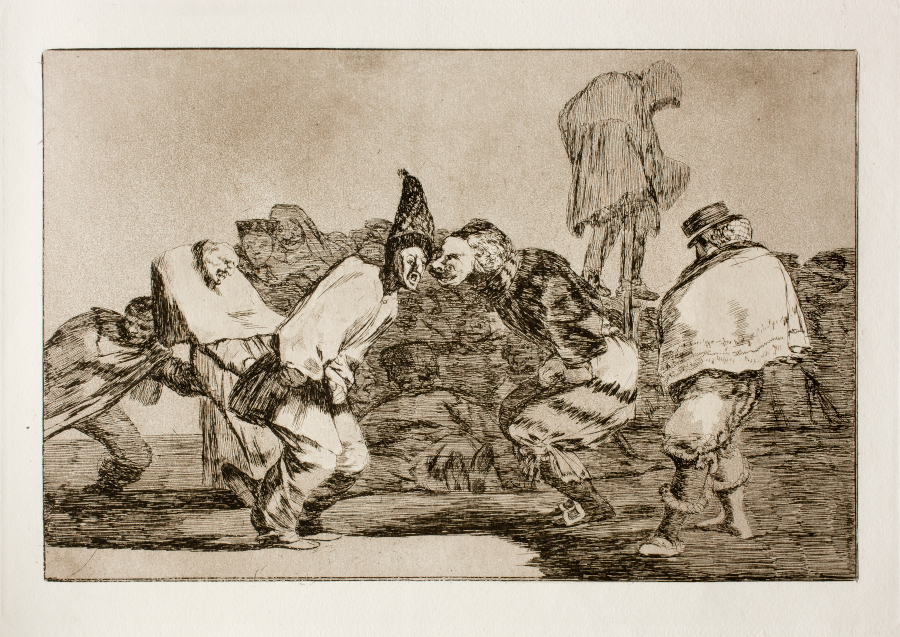
“Carnaval Folly”. Etching 14 from the series “Disparates” (1815). Prado Museum
Final years. The Deaf Man's House and death in Bordeaux.
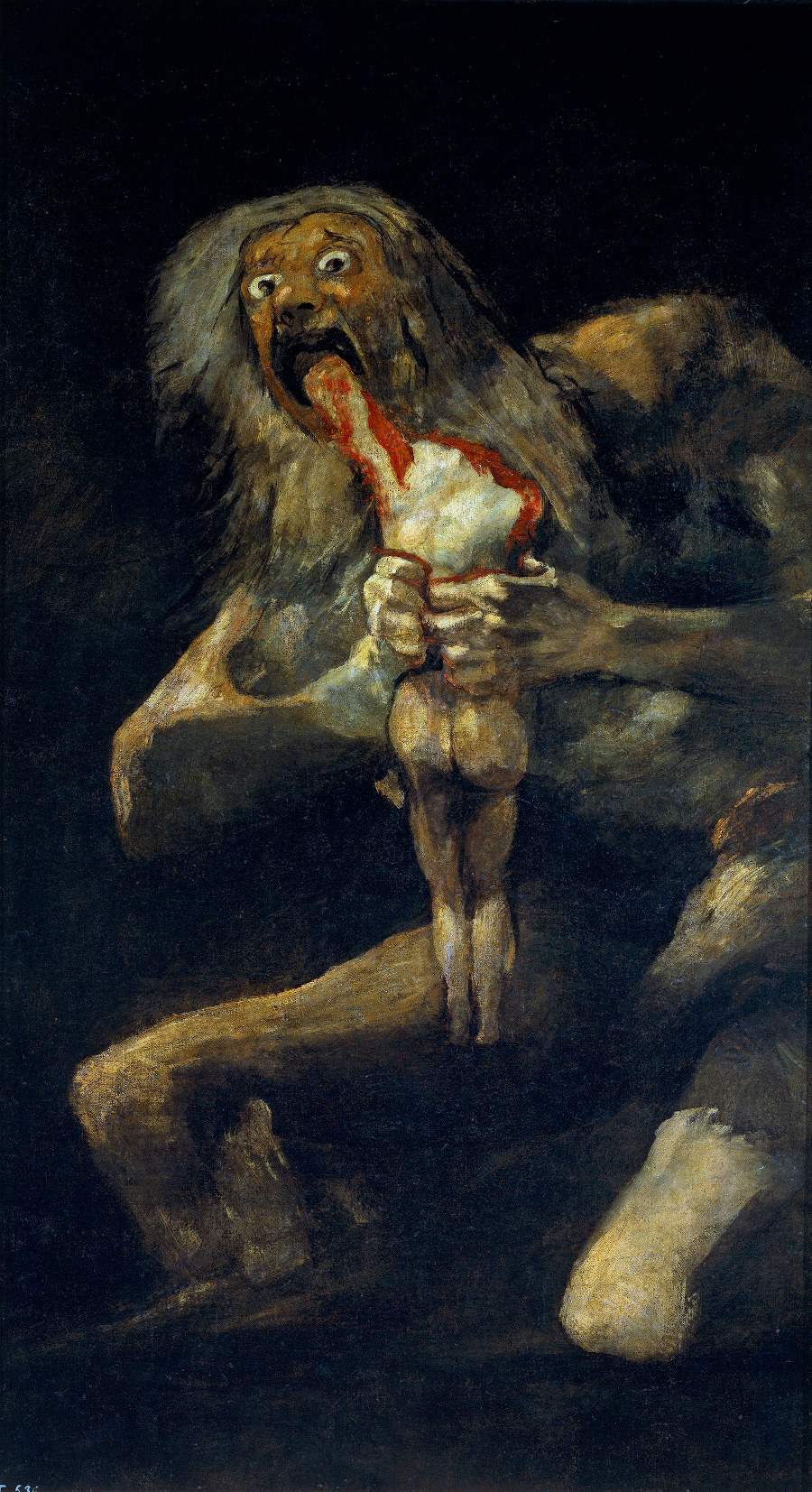
“Saturn Devouring His Son" (1819-23). Prado Museum
By 1819, Goya is 73 years old. The illness, the deafness, his disillusionment with the absolutist government and his problems with the Inquisition have taken their toll on his body, mind and spirit. He acquires the Madrid property he had fallen in love with for its views and ample grounds and it will come to be known as The Deaf Man's House. The elderly painter suffers another severe bout of his illness but lives through it to leave his swansong reverberating around its walls. I refer here to the famous "Black Paintings", where Goya returns to focus on the subjects that had always nested in the depths of his art: death, man's humanity to man, the degradation wrought by the passage of time and the evil hiding in the human soul. In 1824, Goya goes into self-imposed exile in Bordeaux in an attempt to distance himself from the absolutist government he both despised and feared. He is accompanied by Leocadia Zorrilla and her two children, the youngest of whom, Rosario, Goya considers his own daughter and instructs in the art of painting.
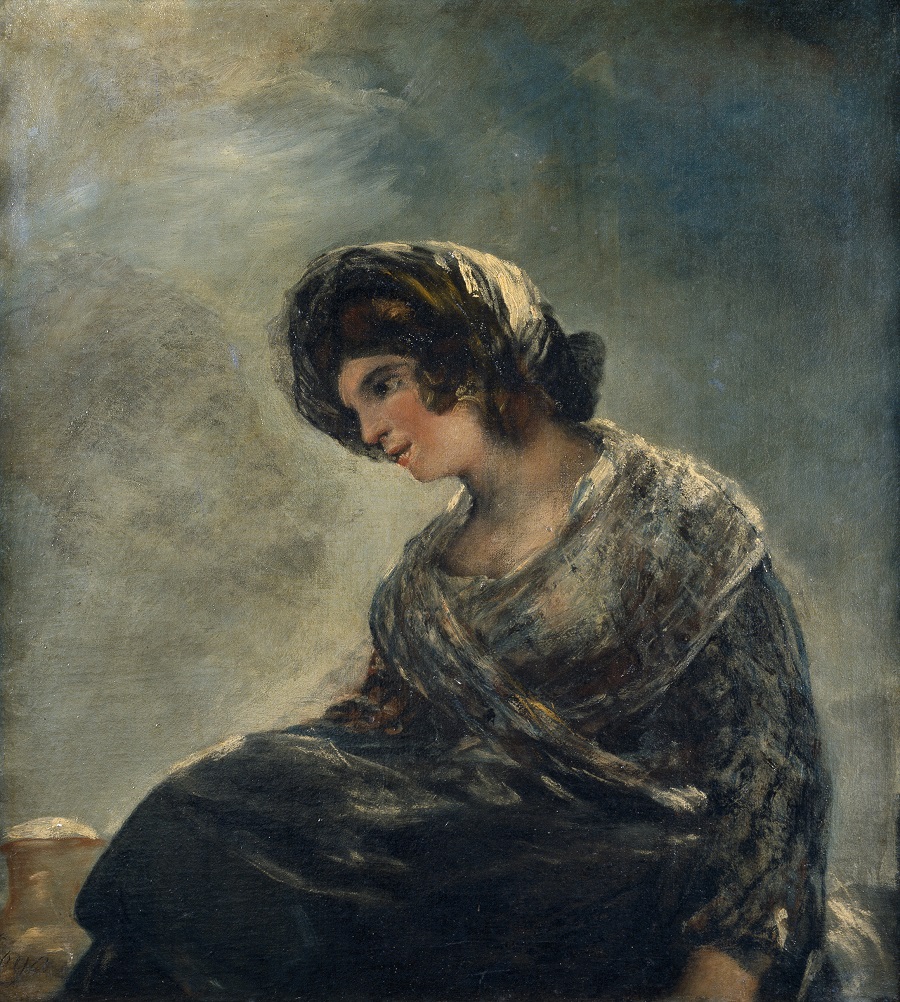
“The Milkmaid of Bordeaux” (1827). Prado Museum
In 1826, Goya is finally able to retire and live out his final years quietly and comfortably-off, dedicated to his graphic work, enriching it with series such as the "New Caprichos", and bullfighting-themed engravings. Standing out among his last works is "The Milkmaid of Bordeaux" (1827), painted a year before his death, that dazzles with its free use of brushstroke, framing, composition and theme, displaying a surprisingly creative and pictorial freedom which foreshadowed the Impressionism of masters such as Renoir and Manet. It should also be pointed out that today, the painting has sparked no little controversy with some experts doubting Goya's authorship and suggesting the possibility that it could actually have been by the hand of his student Rosario. In 1828, Goya dies in Bordeaux, leaving to posterity an oeuvre that is unique in the world, full of creative freedom, modernity, social engagement and beauty.
Exhibitions
Goya in Madrid (2014-15)
The cartoons Goya painted as pattern studies for tapestries were historically considered "minor works". However, these are magnificent paintings in themselves that reveal the master's inimitable hand and foreshadowed artistic movements that would come many decades later. The Prado Museum held an entire exhibition of these cartoons, showcasing them along with those of other artists of the time as well as the paintings and sculptures that served as model and inspiration.
Goya: The Portraits (2015)
In 2015, London's National Gallery celebrated the dazzling work of Goya the portraitist in an exhibition of seventy portraits that, in the institution's own words, "demonstrate his daringly unconventional approach and remarkable skill at capturing the psychology of his sitters." The exhibition included paintings, drawings and miniatures rarely or never-before-seen in the British capital.
Goya and the Enlightened Court, Illustrated (2017)
The Museum of Fine Arts, Bilbao organized this exhibit in collaboration with the Prado Museum and the La Caixa Foundation. The selection included ninety-six works that reflect Goya's activity during his years as a court painter, allowing the public to admire such famous works as "Blind Man's Bluff" and "The Straw Manikin". It was the first ever exhibition dedicated to Goya in the capital of the Biscay province.
Masters of Spain: Goya & Picasso (2018)
Goya shared space with another of Spain's artist greats, Pablo Picasso, in this exhibition organized by the Polk Museum of Art in Florida (USA). More than 50 works of art were on display, including the famous "Tauromaquia" (Bullfighting) series, showcased alongside several pieces created by Picasso on multiple types of media from ceramics to cardboard. Most works were on loan from The Art Company, located in Pesaro, Italy.
Goya. Drawings. "Only my Strength of Will Remains" (2019)
Again in 2019, the Prado Museum dedicated a portion of its exhibition calendar to the work of Francisco de Goya. On this occasion, the exhibition was based on the research and documentation undertaken for the new catalogue raisonné that the museum intended to publish, based on an agreement signed by the Prado and the Botín Foundation. It was the first time that over 300 of Goya's drawings, comprising the Prado's own holdings and loans from collections around the world, were gathered together.
Books
Goya and His Critics. Nigel Glendinning (Yale University Press, 1977 & 2017)
Nigel Glendinning was a renowned scholar on the work of Francisco de Goya. This book, written in 1977 and republished in 2017, is the first document to study the artist and his work through its contextualization in time. The author, who died in 2013, was a pioneer in reflecting on different analyses and studies of the painter's work over decades. The book adds other later studies by the author himself, as well as texts by other experts. In general, this book is considered the most complete study carried out to date on the work of the artist.
Francisco Goya. Life and Works. Valeriano Bozal (TF Editores, 2005)
Valeriano Bozal is a renowned expert on the work of Francisco de Goya and whose contribution can be found in reference books, such as the above-mentioned new edition by Nigel Glendinning. His book Francisco de Goya. Life and Works is an important text for, among other things, the innovative and original point of view it brings regarding the passions and obsessions of the painter. The scholar begins the book with the phrase: "Goya does not lend us his eyes, he opens ours. To the past, to the present." Comprising two volumes, it is an essential work with which to enter the personal world and turbulent times of a once-in-a-lifetime artist.
Goya In Literature. Leonardo Romero Tobar (Marcial Pons, 2016)
Professor of Art Leonardo Romero Tobar has done sterling work on this study, a well-organized and annotated monograph that sheds new light on the work of Francisco de Goya. The text is an extensive collection of annotated bibliographical references, a magnificent contribution for any scholar on the work of the artist. Far from being a collection of quotations and text by the master, the book is a compilation of references that add an interesting analysis of the painter's work, interests and context.
(Translated from the Spanish by Shauna Devlin)
- Francisco de Goya. Biografía, obras y exposiciones - - Alejandra de Argos -

